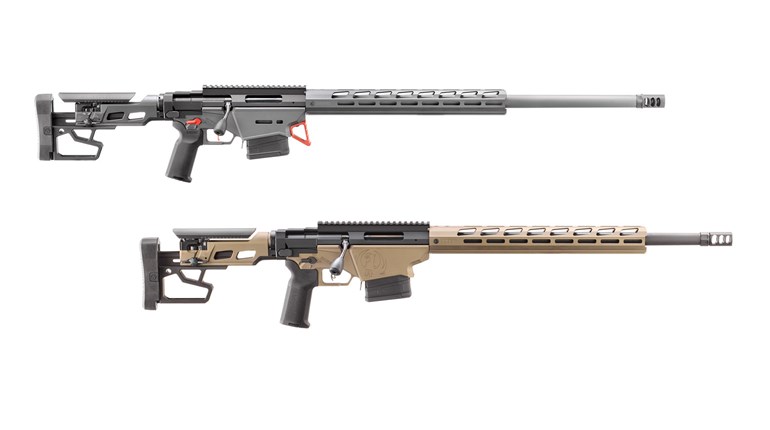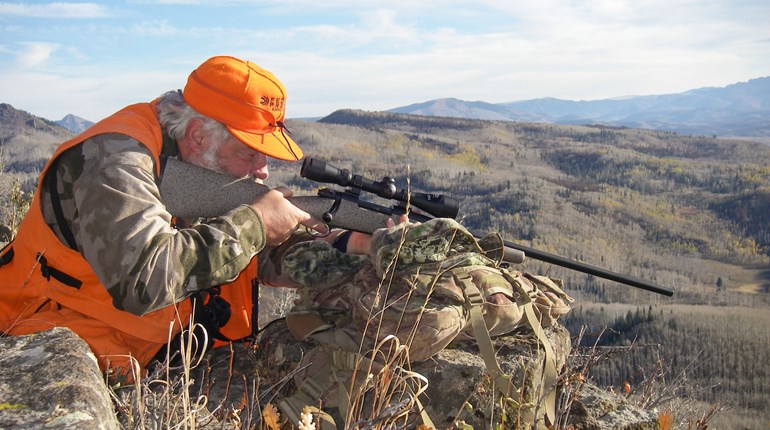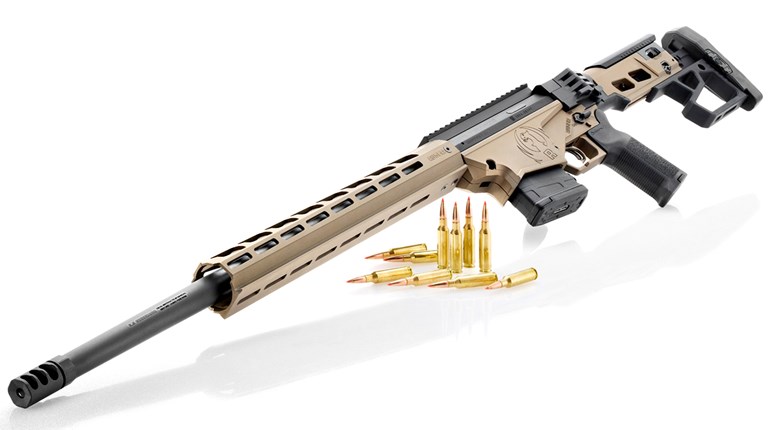
The sport of long-range shooting is always evolving. For many years .30-caliber cartridges dominated. Then along came the 6.5 mm cartridges and they took over, but there is a new contender for the throne with the emergence of the 6mm Creedmoor and other .243-caliber cartridges for long-range work.
The only commercial cartridge in that bullet diameter that has seen much use with precision long-range shooting is the .243 Win. and even that is minimal. As one PRS competitor told me, “I don’t know why exactly, but I just don’t see that many top-level guys shooting a .243 [Win.].”
As exhibit one, I offer that Ruger initially offered the .243 Win. in its Precision Rifle, but it’s no longer listed. The reason? Lack of sales.

Of course, there are some technical issues impeding the use of the .243 Win. for long range, but in the end it’s a “tail wagging the dog” kind of thing. The main problem with the .243 Win. is that it has been promoted as a hunting cartridge. Even as it started to gain a bit of popularity with the long-range shooters, most manufacturers decided to take a “wait and see” approach rather than be an industry leader. None of the big-name ammo makers were willing to load and market high-ballistic-coefficient match bullets for the cartridge. So, we saw the rise of other 6 mm cartridges.
With the increasing popularity of 6mm long-range cartridges it was inevitable that somebody was going to make an honest cartridge out of one of them. It was probably inevitable, too, that it would be Hornady. This company is still small and nimble enough to introduce new cartridges regularly. As a result it is the industry leader in cartridge innovation. As expected, Hornady stuck with its franchise and introduced the 6mm Creedmoor, based on the 6.5 Creedmoor case necked down to take a .243 bullet.

This cartridge was created by a buddy of mine. John Snow is the shooting editor for a popular gun magazine who is also a PRS competitor. He was kicking around the idea of a 6mm cartridge for a new rifle build with his friends at Hornady and they decided to neck down the 6.5 Creedmoor to 6mm Creedmoor. Snow had a rifle built, started writing about it and the cartridge gained in popularity with long-range shooters until Hornady saw an opportunity to take it mainstream and went for it.
From my own perspective, I am writing a new book on gunsmithing that will have a big section on building precision rifles. I built several rifles during the process and perhaps the best of the litter is chambered in 6mm Creedmoor. When I ordered all the parts it was still a wildcat cartridge. By the time I had them all fitted together, Hornady had validated the cartridge and introduced factory ammo to the market soon after.
I had heard rumors and whispers that was going to happen, so I contacted Hornady and obtained a reamer drawing to send to Dave Manson to make a chamber reamer for me. What I thought would be a uniquely different rifle is now mainstream, but that’s fine with me. I can find ammo, brass and bullets easily.
I have no doubt that this year will see a huge number of rifle makers offering the 6mm Creedmoor, but to my knowledge Ruger got there first with its new Ruger Precision Rifle (RPR) in 6mm Creedmoor.
I have one of the Rugers on loan and the first time I shot it was also the first time I had tried the new Hornady 108-grain ELD Match ammunition. As of this writing, it is the only factory load available for the 6 mm Creedmoor.
I shot the ammo first in my custom rifle following the standard Shooting Illustrated accuracy-testing protocol of five, five-shot groups at 100 yards. I didn’t tally the results then, but what I saw through the spotting scope pleased me.
A little later I sat down at the bench to shoot the new Ruger RPR with the same Hornady ammo. As I fired the groups, what I was seeing through the scope was a bit disconcerting. Would this affordable precision rifle outshoot my baby? I ordered the best parts Brownells offers for this rifle and I spent hours making sure that every single part was fitted with exact precision. It would be embarrassing to have an off-the-shelf rifle outshoot it. After I finished the last group, one of my buddies got on the spotting scope and started to heckle me. So, I pulled the targets and measured them with a machinist scale.

The first time out of the gate with the new Hornady 6mm Creedmoor 108-grain ELD Match ammo, my Brownells rifle averaged .6 inches while the Ruger averaged .77 inches. It’s less than .2 of an inch difference, but in the precision shooting world that is enough.
What that tells me is that this is an accurate cartridge. It also tells me that Ruger is going to sell a lot of these rifles. I have worked with more than half a dozen RPR rifles in four different chamberings and every single one has been a great shooter. The first one I tried shot so well that I sent Ruger a check. I hardly needed another 6.5 Creedmoor rifle, but it was too good of a shooter to send it back to Ruger. With a little tweaking this new 6mm Creedmoor RPR is going to approach being a .5-MOA rifle and it’s going to be hard to send back as well. (You see, this is why I’ll die broke.)
Why the 6mm Creedmoor over the 6.5? Simple: speed. Sure, the lower recoil is a benefit when you are a competitive shooter and/or trying to spot your own hits, but terminal ballistics improve with speed. If the bullet is flying faster it has less time for gravity to act on it. The acceleration of gravity causes a bullet to drop to the earth at a rate of 32 fps. So, the longer it’s in flight, the faster it is dropping and the steeper the trajectory curve becomes. With a sharper trajectory curve from a faster bullet, the margin of error becomes a little larger at any given distance.
On the Hornady website, the 108-grain 6mm Creedmoor is 250 fps faster than its 140-grain 6.5 Creedmoor load. Velocity varies from rifle to rifle and in the real world is often different. I went to my database of guns and ammo I have tested and calculated an average of 19 strings using several varieties of 6.5 Creedmoor 140-grain factory ammo. The data includes several factory-ammo products and a bunch of different rifles and encompassing hundreds of measured velocities. The average muzzle velocity is 2,658 fps.
Of course, the factory load database is much smaller for the 6mm Creedmoor, but from the RPR the Hornady 108-grain load averaged 2,944 fps. From the longer 27-inch barrel on my custom rifle the average velocity is 3,067 fps. That gives an average of the two of 3,005.5 fps. When we subtract the average 6.5 velocity we see a difference of 347 fps, which is not insignificant. That means the 6mm Creedmoor is traveling more than 100 yards per second faster than the 6.5 bullet when it leaves the muzzle. The 6.5 travels 721 yards in its first second of flight while the 6mm covers 773 yards. If the ballistic coefficient matched, the 6mm would cover 804 yards in the first second.

At 500 yards, the Hornady 6.5 140-grain ELD has dropped 74.22 inches. The 6mm 108-grain bullet has dropped 59.85 inches. With a 200-yard zero, that means the 6.5 impacts 43.74 inches below the line of sight while the 6mm impacts 34.89 inches below the line of sight. The time in flight is .64876 second for the 6.5 and only .58654 second for the 6mm.
I ran the numbers out to 1,000 yards and the 6mm maintains the edge. Drop: 370.45 vs. 311.58 inches. Path with a 200-yard zero: -306.79 vs. -258.96. Time in flight: 1.52050 vs. 1.41536 seconds.
At 68 degrees Fahrenheit and in dry air, the 6.5 goes subsonic at 1,482 yards, while the 6mm drops below the 1,125 fps threshold at 1,428 yards. Wind drift with a 10 mph full value at 3 o’clock is 14.86 inches for the 6.5 at 500 yards. The 6mm drifts 15.38. At 1,000 yards, it’s 68.96 for the 6.5 and 73.40 for the 6mm.

So, there is a ballistic advantage for the 6mm, at least in trajectory.
The downside? The ballistic coefficients for the 6mm bullets are a bit lower than the 6.5mm bullets on average. The wind blows the lighter, lower BC bullets around a bit more. Also, the smaller bullet makes it harder to see the hits on steel. If you were in a tactical situation, it causes less damage on impact.
So why is the Creedmoor-style case a better choice for precision long-range shooting? Short-action rifles are limited to a cartridge overall length of 2.8 inches. Most cartridges are designed so that they do not exceed that with the popular bullets expected to be used. The .243 Win. and .260 Rem. were designed around hunting bullets. Then along comes long-range shooting and the long, sleek, high-BC bullets used for that game. If they are seated out long enough so they don’t intrude into the powder space, the cartridge will not fit in the rifle magazine and likely will not chamber. The reality is that this is not a huge problem. Simply seat the bullet deeper. It eats up a little of the available powder space, but so what? The key is to have the bullet the correct distance from the rifling lands for optimal accuracy, not how deep it is in the case. The trouble is shooters don’t like the idea of seating the bullet into the case. I think it’s one of those myths that keeps being repeated by lazy gunwriters and gun-store-counter commandos until it is accepted as truth. However, another more-real problem is that most factory rifles use a twist rate in the rifling that will not stabilize the long bullets.

In any event, the Creedmoor concept is to optimize the cartridge length for use in a short-action rifle with the heavy and long bullets favored by long-range shooters. The chamber leade, throat angle and rifling twist rate are also optimized for these bullets. Hornady’s recommended twist rate for the 6mm Creedmoor is, 1:7.5-inch. The Ruger uses a 1:7.7-inch twist rate. My “Brownells” rifle is a 1:8-inch.

The two Creedmoor cartridges share common dimensions except for the neck diameter and the corresponding changes to the shoulder that results. The cartridges share a .473 diameter case head, the same as the .30-’06 Sprg. family of cartridges. They have a 30-degree shoulder and the case length is 1.920 inch. That is, of course, shorter than the .243 Win., which is 2.045 inches.
The 6mm Creedmoor has an overall cartridge length (OCL) of 2.800 inch, which optimizes it to fit a standard short action and is longer than the .243’s OCL. So, the case for the 6mm Creedmoor is .125-inch shorter than the .243 Win. and the cartridge overall length is .09-inch longer. What that means is that this cartridge is designed to have a lot of bullet sticking out of the front end.
The 6mm Creedmoor is a cartridge that is designed for a specific purpose: the sport of long-range shooting. In testing it so far, it does this job extremely well, and my guess is that it will very quickly become one of the dominant cartridges in the sport.




































